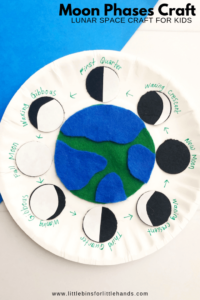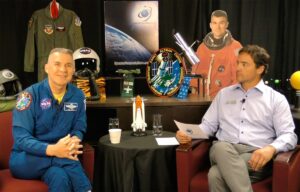It’s never too early to start educating children about space. With a growing space industry, the youth are the future of space development. Here are several space activities for kids that are perfect for at-home learning or the school classroom.
1. Go on a virtual field trip to a space museum.
 Nothing brings the wonder of space to life quite like a trip to a space museum. Kids of all ages are captivated by real-life space artifacts, planetarium shows and hands-on space activities. And with virtual field trips, you can bring the space museum right into your home or classroom! Many of the world’s finest space museums now offer online experiences.
Nothing brings the wonder of space to life quite like a trip to a space museum. Kids of all ages are captivated by real-life space artifacts, planetarium shows and hands-on space activities. And with virtual field trips, you can bring the space museum right into your home or classroom! Many of the world’s finest space museums now offer online experiences.
Space Foundation Discovery Center offers interactive virtual field trips for students K–12. Kids can tour the solar system with Science On a Sphere® and learn about rocketry, engineering, robotics, weather or Mars exploration. The museum also offers a virtual version of its popular Mars Robotic Laboratory, where students program and operate LEGO EV3® robots to complete mission objectives on a simulated Martian terrain!
See field trip program options here.
2. Try these space crafts and experiments.
Edible Moon Phases
Many kids are curious about the Moon and why it looks different every night. Here is a delicious way to learn about moon phases while enjoying an afternoon snack!
You’ll need a moon phase chart like this one for reference. 
-
- Twist open seven chocolate sandwich cookies (i.e. Oreos) and place one chocolate and seven iced halves on a paper plate or clean piece of paper.
- The chocolate half is the new moon. Keep one fully iced half for the full moon.
- To make the remaining six moon phases, use a knife to gently remove part of the icing on each cookie half to match the chart.
- Label each moon phase on the plate or paper and review each one. You can play a matching game by removing all the cookie halves and having your kid(s) put them back with the correct label.
- Eat the cookies!
Little Bins Little Hands created additional variations on this moon phase activity.
Make a Mini-Garden
One of the most valuable aspects of space exploration is the data it provides on Earth’s climate and weather patterns. Kids can learn about Earth’s atmosphere and how it helps life flourish by planting and tending a mini-garden terrarium of their own. This project will teach them how light, water and oxygen affect the growth of plants.
You will need:
- A glass bowl, container, vase or jar (check your local thrift store for great inexpensive options!)
- Small rocks
- Soil
- Activated charcoal
- Small
plants (your local plant nursery will often carry tropical terrarium plants or succulents) - Optional decorative items (stones, small toys, shells, figurines, mini gnomes, etc.)
Place an inch-thick layer of rocks on the bottom of the container, topped with about a half-inch of
activated charcoal. This will help drain and collect extra water, and prevent the growth of fungi. Then, add the soil until the container is half full.
It’s time to plant and decorate! Plant the plants, being careful not to disturb the roots. Don’t crowd in too many plants—they need room to breathe. Add any decorative items for a final touch!
Place the bowl in indirect sunlight. Water according to specific plant guidelines.
NASA Climate Kids has more ideas and recommended plants for this project.
Make Astronaut Food!
What’s more fun than activities that include food? This activity is not only easy, but a great way to keep kids engaged.
Here’s what you will need:
- Fresh fruits (e.g. peaches, strawberries, apples, grapes, or bananas)
- Fresh vegetables (e.g. green beans, zucchini, squash)
- A food dehydrator (an oven at 220° degrees can be used)
- Balance scale
- Plastic zipper sandwich bags (enough for all the food samples)
Here are the steps:
- Explain how dehydrating food means removing (most of) the water in foods, which makes them last longer and travel better. Discuss with kids how using dehydrated foods for space travel gives astronauts access to more solid foods and a better, more nutritious, overall diet. Rehydratable foods and drinks also allow for a significant weight reduction during space travel.
- Show the scale to the kids. Explain that you are going to measure and weigh each piece of fruit/vegetable before you start to determine the amount of water in each piece.
- Carefully record the weights and measurements in your science journal.
- Help the kids to cut or slice food into small pieces (or do it yourself if kids are too young to handle cutting implements). Ensure that they record the exact weights and sizes in their science journals as they cut fruits and vegetables. Monitor the students as they weigh their samples to ensure accuracy.
- Explain and demonstrate what a food dehydrator does. If you do not have one, explain to the kids that you’ll be placing the samples in an oven set at 220 degrees so that the heat can slowly evaporate the water in the food. Place the food items in the dehydrator, and begin the process of dehydration. Explain that this will take several hours. You may want to already have pre-dehydrated food items available for the kids to sample.
- Dehydrate the food and then allow the food time to cool. Once cooled, place the food in a plastic sandwich bag so moisture will not be reabsorbed.
- Explain how the plastic bag is important as dehydrated food can absorb water directly from the atmosphere.
- Demonstrate how to precisely weigh and measure the dehydrated food. Model how to weigh and then subtract the weight of the empty plastic bag from the weight of the sample bag (the resulting number is the weight of the empty bag).
- How much lighter is the food with the water removed? Record the results in your science journals.
- Enjoy the tasty dehydrated food, just like real astronauts!
You can adapt this lesson for students’ ability levels, such as teaching how to calculate the moisture loss. Here are more details about this activity.
3. Teach kids about space careers.
Many children aspire to be scientists, doctors, meteorologists, photographers, and many other careers. Most of these careers have their own place in the space industry. Many children might be surprised to learn about these possibilities. You can have kids fill out a short questionnaire about their interests, and then identify what space career has some of those similar components to the job!

You can take this activity a step further by helping children research influential people in the space industry. They can learn about where they grew up, what they studied in college, and how they got their job. This activity’s engagement level can be tailored for their age level, but young and older kids can learn about STEAM achievers and how they became successful.
If you want students to learn about some of these roles in space, we feature interviews with Retired Astronaut Lt. Col. Duane “Digger” Carey in our Audience with an Astronaut series.
4. Try these STEAM lesson plans.
Center for Innovation and Education supports children’s education through STEAM Lesson Plans designed for students who are ready to learn about space. These lesson plans take the stress out of planning and are ready to implement.
Each lesson plan suggests the appropriate grade levels it’s designed for, the subject matter it covers, instructions, and “real-world” skills that it directly improves. These activities are hands-on and perfect for getting students engaged in space.
Looking for more ideas?
Center for Innovation and Education has plenty of resources for you! Check out our Programs for Teachers for STEAM lesson plans, e-learning tools, grant lists and professional development opportunities. Our Students page includes programs, STEAM activities and more for you to explore.